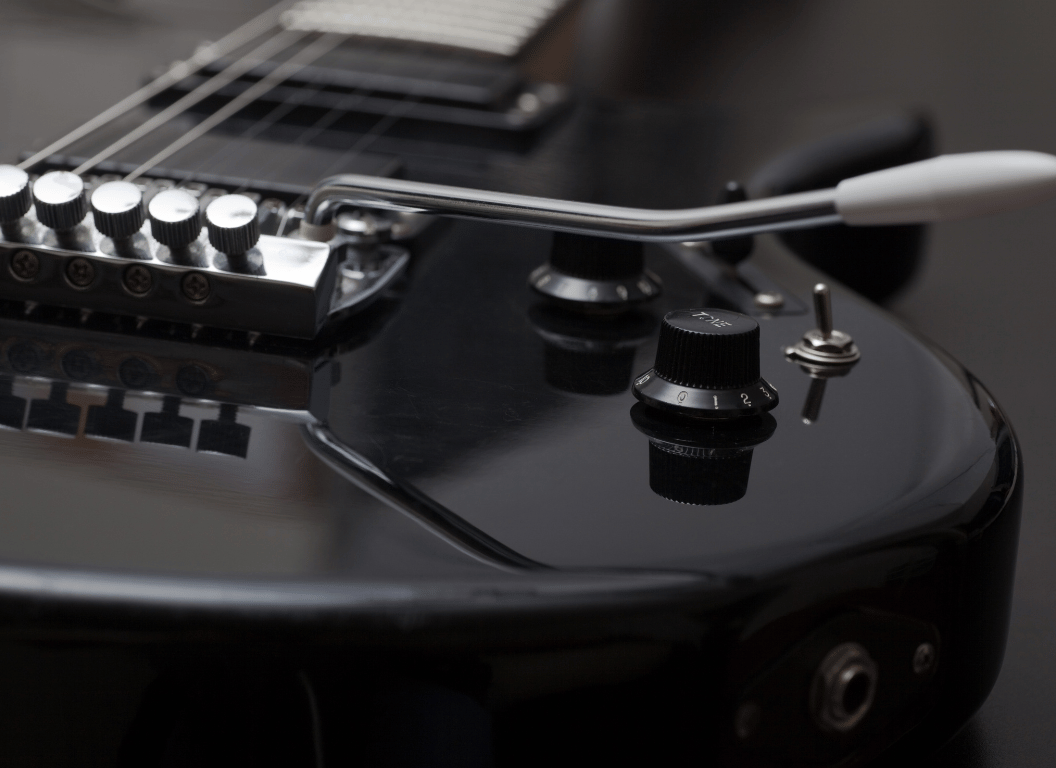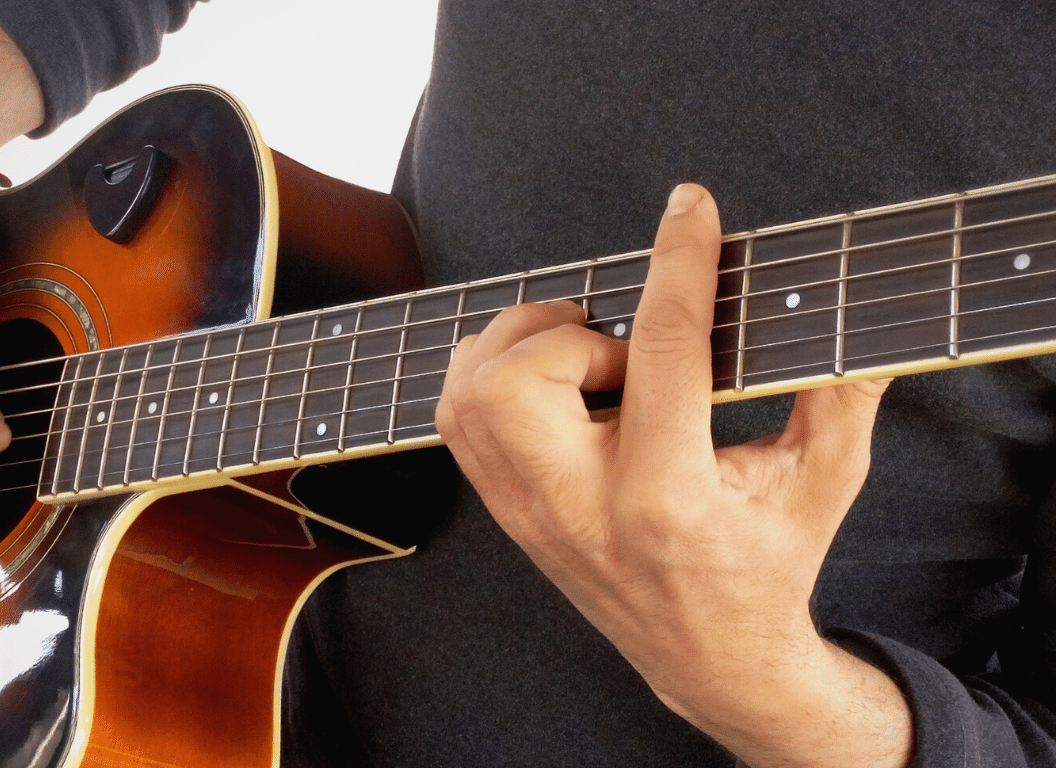The intricacies of guitar playing often extend beyond mere strumming and picking.
Exploring and harnessing the power of different guitar tools can vastly enhance your musical expression.
One such tool that merits attention is the whammy bar.
This dynamic device significantly expands the range of possible sound effects.
Its proper utilization can enhance your performance, allowing you to create a unique persona for each musical piece.
However, the effective usage of a whammy bar necessitates an understanding of its functionality and applications.
Table of Contents
- How To Use A Whammy Bar Effectively?
- What Is the Purpose of a Whammy Bar?
- Basic Techniques for Using a Whammy Bar
- Common Mistakes When Using a Whammy Bar
- Whammy Bars vs. Tremolo Arms?
- Best Practices for Whammy Bar Maintenance
- Can You Use a Whammy Bar on Any Guitar?
- The Impact of Whammy Bar on Guitar Tone
- Famous Guitarists Who Commonly Use Whammy Bars
- How Often Should You Replace Your Whammy Bar?
- Innovative Ways to Use a Whammy Bar
- The Bottom Line
How To Use A Whammy Bar Effectively?
To use a whammy bar effectively, first insert it into the tailpiece of your guitar, then practice gently pushing or pulling on it to create pitch bends or vibrato effects. You should avoid overuse or heavy use as it can cause the guitar to go out of tune. Mastering the technique requires practice and subtlety to incorporate it smoothly into your performances for expressive, dynamic pitch manipulation.
While the preliminary guidance illustrates the basics of whammy bar use, it’s crucial to delve deeper into its potential for enhancing musical expression.
In the subsequent segments, we’ll explore further techniques and the musical theory behind them, including how to leverage the whammy bar for dive bombs, scoops and flutters.
Plus, we’ll discuss crucial maintenance tips that can keep your guitar performing well even with consistent use of the tremolo arm.
Also, understanding the impact of the whammy bar on your guitar setup and the appropriateness of its use in different music genres will be addressed.
Strap in for a comprehensive dive into the world of whammy bars!
What Is the Purpose of a Whammy Bar?
The whammy bar, also known as a ‘tremolo bar’, serves a distinct purpose in guitar playing.
When we talk about a guitar’s accessory such as a whammy bar, its primary purpose is to add vibrato to the sound.
Unlike other vibrato techniques, the whammy bar changes the tension of the guitar’s strings, thereby altering the pitch.
This ability to alter pitch creates expressive, human-like qualities in the music played on the guitar.
The bar enables musicians to go beyond the limitation of standard notes, creating a wider range of sound.
With the aid of a whammy bar, guitarists can create dramatic pitch bends and dive bombs, offering a whole new dimension to their playing.
It allows the player to quickly fluctuate the tension on the strings and create a vibrato effect.
This flexibility provided can manifest in guitar solos, enriching the overall musical narrative and engaging the audience intimately.
With the aid of a whammy bar, guitarists can create dramatic pitch bends and dive bombs, offering a whole new dimension to their playing.
The quoted text is not just a claim, but a fact in the world of music.
Artists such as Jimi Hendrix and Jeff Beck have used the instrument to breathtaking effect, thereby pioneering its use and setting the stage for future guitarists.
Not only does the whammy bar allow for extraordinary pitch alterations, it also permits nuanced expression.
Its light manipulation can induce delicate and subtle details in the music, transcending the ordinary auditory experience.
For example, a light touch on the bar can slightly color a sustained note, creating a beautiful, emotional effect.
The whammy bar thus plays a crucial role in shaping the sonic character of guitar playing.
Checking out the video can give you a practical idea of how a whammy bar is used.
It could demonstrate the various tones and sounds that can be generated with its proper handling.
In the hands of a knowledgeable player, the whammy bar can fluidly transition from wild to subtle, its expressive potential limited only by the player’s creativity.
Its light manipulation can induce delicate and subtle details in the music, transcending the ordinary auditory experience.
Indeed, the bar’s expressiveness can enhance the emotional connection between the player and the listener.
It may introduce a certain depth and complexity to the music, capturing the listener’s interest and keeping them engaged.
Basic Techniques for Using a Whammy Bar
Like any skill on an instrument, effective use of the whammy bar requires consistent practice.
Start by simply strumming a chord, then gently pushing the bar down and releasing it.
Notice the change in pitch and take note of how hard you’re pressing down on the bar.
Start by simply strumming a chord, then gently pushing the bar down and releasing it.
This exercise allows you to get familiar with the effect of the bar on pitch, as well as to gauge how much pressure to apply.
Gradually, you can start using the whammy bar in conjunction with different chords and notes to create unique musical effects.
Once you have gained control over the basic use of the whammy bar, you can start exploring advanced techniques.
One common method is the “dive bomb”, where the bar is aggressively pushed down to create a rapid drop in pitch.
To perform a successful dive bomb, a strong pick hand technique is needed along with a controlled use of the whammy bar.
You can also incorporate the whammy bar into legato techniques such as hammer-ons and pull-offs to create complex musical textures.
You can also incorporate the whammy bar into legato techniques such as hammer-ons and pull-offs to create complex musical textures.
The use of the whammy bar in these techniques makes the typical legato sounds even more expressive.
The whammy bar is a powerful tool in the hands of a skilled guitarist, capable of producing exciting and dramatic musical effects.
Common Mistakes When Using a Whammy Bar
Often, beginners view the whammy bar as a sort of toy and misuse it, leading to out-of-tune guitars and potentially damaging the bridge.
Correct usage of a whammy bar adds a vibrato effect that can enhance the quality of the music if done right.
However, too much use of it can lead to more harm than good, with a negatively impacted guitar intonation.
The correct usage of a whammy bar adds a vibrato effect that can enhance the quality of the music if done right.
It’s about understanding the balance between creating an interesting sound effect and ensuring the health of your guitar.
– Not Properly Tuning After Use
Another common mistake that guitarists make is not tuning their guitar after extensive use of the whammy bar.
The constant pressure and release can knock the strings out of tune, so it’s crucial to re-tune your guitar frequently when using this tool.
A video link is provided here that can provide additional understanding about the use of a whammy bar.
Often, visual instructions are quite helpful.
– Overuse of the Whammy Bar
An additional mistake to note is the overuse of the whammy bar.
It is often best used sparingly, to accentuate a note or phrase, rather than becoming a constant feature of your playing.
The excessive use of a whammy bar can also lead to string breakage, especially if the strings are old or of low quality.
The excessive use of a whammy bar can also lead to string breakage, especially if the strings are old or of low quality.
Having a light hand and understanding the limits of your guitar and strings can significantly increase their lifespan.
– Using the Whammy Bar as a Crutch
Some guitarists make the mistake of using the whammy bar as a way to hide their technical shortcomings.
To fully exploit the creative possibilities it offers, it’s essential to master your basic guitar technique first and then incorporate the whammy bar.
While the whammy bar can help you to make interesting and challenging music, it should augment your skills, not replace them.
The goal is to use it as a tool to enhance your music, not as a crutch to cover up deficiencies in your technique.
Whammy Bars vs. Tremolo Arms?
The tremolo arm is a somewhat misnamed device because it doesn’t create a true tremolo effect.
The term tremolo refers to a rapid repetition of a single note or an alternation between two or more notes.
As it happens, the tremolo arm cannot create this effect.
Instead, the tremolo arm operates just like a whammy bar (because they’re essentially the same thing).
This confusion in terminology was a mistake made by Leo Fender in the 1950s when he first introduced his innovative guitar design.
Fender labeled the “whammy bar” a “tremolo arm” when he should have used the term vibrato arm, as it provides pitch modulations similar to vibrato.
Despite knowing about his error, Fender continued to use the term because it had already started to catch on among players and within the industry.
To this day, the terms tremolo arm and whammy bar are used interchangeably, even though it’s more accurate to say that a ‘vibrato’ bar is what they truly are.
Best Practices for Whammy Bar Maintenance
Improper use or neglect can drastically affect the instrument’s performance over time.
Thus, it’s not just about knowing how to use it, but also about learning how to take care of it.
Just like any other part of the guitar, the whammy bar should be used properly to avoid unnecessary damage and to ensure its longevity.
It’s worth mentioning that overuse or applying too much pressure can strain the bar and lead to severe damage.
Moderation is key when using the whammy bar, and that starts with understanding how much pressure to apply and knowing when to use it,” says experienced guitarist and music teacher, Paul Gilbert.
In support of this point, applying too much pressure will not only harm the bar but can also put the guitar out of tune.
This will definitely affect the quality of sound produced.
Moreover, guitarists, especially beginners, should keep in mind that the whammy bar is meant to add flair and nuance to the sound, not to be the main feature of their playing style.
Another critical aspect of maintaining the whammy bar is regular cleaning.
It’s crucial to clean the bar, along with the bridge and tremolo system, to avoid build-up that could affect its function.
You could use a simple dusting cloth or guitar cleaning products, specially designed for such purposes.
Regular dirt and grime can cause the tremolo system to seize up and ultimately make the whammy bar inoperable.
“Cleaning the whammy bar ensures it can move freely in the bridge and maintain precise intonation,” highlights guitar technician Richie Blackmore.
In other words, cleaning not only improves the functionality but also prolongs the life of the bar.
Therefore, it’s essential to keep it clean and well maintained.
This video showcases a detailed look at maintaining a whammy bar, its set up, and how to keep it performing at peak conditions.
By viewing this video, you can learn the intricacies of whammy bar maintenance, which will augment your understanding and help apply these best practices effectively.
Inspection of the whammy bar should be part of your regular routine.
It is necessary to check the bar for any signs of wear and tear.
Be attentive to any signs of stress fractures or bending in the bar itself, which could hinder its functionality and lead to a potential breakage.
Also, the parts that hold the whammy bar to the guitar, such as the bridge and the springs in the tremolo system, should also be checked regularly.
Inspecting the bar and its corresponding parts will help to spot any potential problems early on,” guitar expert Eddie Van Halen reminds us.
Keeping a regular check will help you to anticipate issues and take preventive measures ahead of time, ensuring a long life for your whammy bar and even more satisfying guitar playing experience.
Can You Use a Whammy Bar on Any Guitar?
Understanding the operational dynamics of a whammy bar is vital when considering its application on any guitar type.
The key factor determining the usability of a whammy bar is whether the guitar has a tremolo system.
Whammy bars are specifically designed to work with such systems, which involves a mechanised method for adjusting the tension of strings.
Guitars come in all shapes and sizes with differing structural configurations, but not all come with a built-in tremolo system.
Not all guitars come with a built-in tremolo system.
This means you cannot use a whammy bar on any guitar.
You can only use it on those guitars that have a compatible tremolo bridge – a special kind of bridge that facilitates the use of a whammy bar.
Commonly, electric guitars like the Fender Stratocaster and Gibson Les Paul, are equipped with a tremolo system.
With these, you are able to add a whammy bar to create pitch-bending effects.
On the contrary, most acoustic guitars do not have a tremolo system.
Their design does not support the required mechanics for a whammy bar’s operation.
Consequently, they cannot accommodate the accessory.
Most acoustic guitars do not have a tremolo system; hence, they cannot accommodate a whammy bar.
However, it’s worth noting that a few high-end semi-acoustic and electro-acoustic models do have tremolo systems and can therefore accommodate a whammy bar.
Ultimately, the design structure and features of your guitar will determine whether or not it can be used with a whammy bar.
The Impact of Whammy Bar on Guitar Tone
When used effectively, the whammy bar can significantly enhance a guitar’s expression.
It offers a fluid transition from note to note, enabling users to execute pitch bends and vibratos that can’t be achieved using traditional left-hand vibrato techniques.
The bar also allows performers to create dramatic tonal effects like dives and swoops, expanding the possibilities for sonic expression.
Creating dramatic tonal effects like dives and swoops, expands the possibilities for sonic expression.
Swoops, for instance, can add a sense of drama and suspense to a piece.
Similarly, dives can be used to alter the intensity of a piece, infusing it with an extra layer of depth and emotion.
By watching this video, you can gain insights into how to effectively use a whammy bar to alter guitar tones.
It provides practical examples, showcasing how to use these techniques to their full potential.
The type of guitar, as well as the type of whammy bar being used, both significantly impact the tone that is produced.
For example, a floating whammy bar system will produce a different tone than a vintage style one, due to its ability to lower and raise pitch.
Understanding your equipment and how it interacts with the whammy bar is essential to bring out the most appealing tone.
Thus, a whammy bar can truly open up new dimensions in a guitarist’s tonal vocabulary.
But, as with any tool, mastery takes practice, and the more you understand about its potential and limitations, the more control you will have over your sound.
Famous Guitarists Who Commonly Use Whammy Bars
In an exploration of iconic guitarists, the use of whammy bars stands as a major distinguishing factor.
However, the technique isn’t just for show; it requires artistic skill to master.
Here are a few famous guitarists who have commonly used whammy bars in their performances.
– Eddie Van Halen
Eddie Van Halen, the sensational rocker, was known for his expressive use of the whammy bar.
His bands, Van Halen, has several tracks showcasing his unique ability to control pitch and tone through the bar.
He profoundly influenced rock music with his tapping style and whammy bar techniques.
His bands, Van Halen, have several tracks showcasing his unique ability to control pitch and tone through the bar.
This virtuosic use of the whammy bar set a remarkable trend in the rock genre.
His performances demonstrated how whammy bars can serve as an important tool in a guitarist’s arsenal.
– Jeff Beck
Another guitarist who popularized whammy bars in his performances is Jeff Beck, one of the three notable guitarists who emerged from the band, The Yardbirds.
Beck’s style is much more melodic and dynamic, often seen manipulating the whammy bar in his solos.
His playing style relies heavily on the bar for expressing the emotional depth of his music.
Beck’s style is much more melodic and dynamic, often seen manipulating the whammy bar in his solos.
Jeff Beck’s performances stand as a classic example of a player who harmoniously blends the whammy bar with his playing style.
This unique combination exemplifies the extent to which a guitarist can use the whammy bar to evoke emotion from their audience.
– Steve Vai
Steve Vai is known for his whammy bar abilities and became an idol for many aspiring guitarists in the 80s and 90s.
His use of the whammy bar was innovative and inspired a whole new generation of guitar players.
Bar dive, flutter, and harmonic squeals are some of the techniques he innovatively used with his whammy bars.
His use of the whammy bar was innovative and inspired a whole new generation of guitar players.
Steve Vai’s unique techniques have made the whammy bar a significant aspect of electric guitar playing.
His music provides a great foundation for understanding the potential of whammy bars in modern music.
How Often Should You Replace Your Whammy Bar?
Regarding the replacement frequency, there’s not a definite answer as it depends on several factors like the quality of the bar, how the guitar is used, and even the environment it’s stored in.
However, a whammy bar typically lasts for two to three years under moderate use.
That said, it’s important to constantly check the bar for signs of wear and tear or any change in functionality.
This video provides a practical guide on how to replace a whammy bar, ensuring you do it correctly without damaging your guitar.
Additionally, the tutorial brings you a visual understanding of the overall process, making it far easier for future replacements.
Now that we know the average lifespan of a whammy bar, it’s equally important to know when it’s the right time to replace it.
Playing difficulty is one of the initial signs you might need a new whammy bar.
If the guitar goes out of tune quickly or the bar itself becomes loose and hard to control, these may be signals telling you it’s time for a replacement.
If the guitar goes out of tune quickly or the bar itself becomes loose and hard to control, these may be signals telling you it’s time for a replacement.
Aside from performance, if the whammy bar shows signs of physical damage such as rust or erosion, it should also be replaced immediately.
Following these guidelines will ensure smooth performance and longevity of your guitar.
Keep in mind, regular maintenance and inspections will always keep your guitar at its best.
Innovative Ways to Use a Whammy Bar
One innovative way to use a whammy bar is to create tonal variations.
Tonal variations refer to changing the pitch of the note.
Instead of using a vibrato technique on the fret hand, use the whammy bar.
By gently pushing and releasing it, you can create microtonal pitch fluctuations to give character to long sustained notes.
This technique also aids in masking any inconsistencies in the pitch of fretted notes.
So, for those struggling with perfect pitch, the whammy bar can be used as a pitch corrector.
By gently pushing and releasing it, you can create microtonal pitch fluctuations to give character to long sustained notes.
As elaborated in the above quote, the whammy bar genuinely shines when adding character and uniqueness to long musical notes.
Musicians typically use tonal variations to make their music more impactful or expressive.
The whammy bar allows them to do this quickly and effectively.
– Creating Dive Bomb Effects
Another innovative usage of the whammy bar is to create dive bomb effects.
The dive bomb effect is achieved by striking a string and immediately depressing the bar, causing the pitch to lower dramatically.
This creates a sound similar to that of a plane diving, hence the term ‘dive bomb’.
This effect is most notable in the rock and metal genres, proving popular amongst guitarists for its dramatic and attention-grabbing character.
The dive bomb effect is achieved by striking a string and immediately depressing the bar, causing the pitch to lower dramatically.
The dive bomb effect might seem complex, but it’s effectively achieved with a strategic use of the whammy bar.
The effect remains popular among rock and metal guitarists to create a sense of drama and add a unique element to their performances.
– Developing the Flutter Effect
The third innovative way to use a whammy bar is to develop the flutter effect.
The flutter effect is popular among modern guitarists, often used in solos.
It’s achieved by quickly bouncing the bar up and down, imparting a rapid oscillation in pitch to the strings.
Once mastered, the flutter effect becomes an expressive tool in a guitarist’s arsenal, driving music with a unique vibrancy that’s hard to replicate with other techniques.
The flutter effect is popular among modern guitarists, often used in solos.
Creating the flutter effect requires a level of expertise and control over the whammy bar.
However, when achieved, it helps create a distinctive sound, adding a unique touch to any guitarist’s repertoire.
The Bottom Line
To encapsulate, the whammy bar can be a guitar player’s best friend, if used correctly.
Its purpose goes beyond simply altering pitch, bringing a distinct creativity and expression to a performance.
While it has its own unique techniques, there are common pitfalls that can be avoided with knowledge and practice.
It’s important to distinguish it from the tremolo arm, and to partake in regular maintenance for its longevity.
While not every guitar is compatible, the impact it has on guitar tone is distinct and even renowned among legendary guitarists.
The frequency of replacement depends on several factors, yet innovation is always imminent.
Overall, mastering the whammy bar can completely transform your guitar playing experience.

More than 10 years of experience playing and writing about guitars! When not writing, I can be found strumming away some Johnny Cash tunes. Favorite all time guitar is the Gibson Les Paul. #TeamGibson




